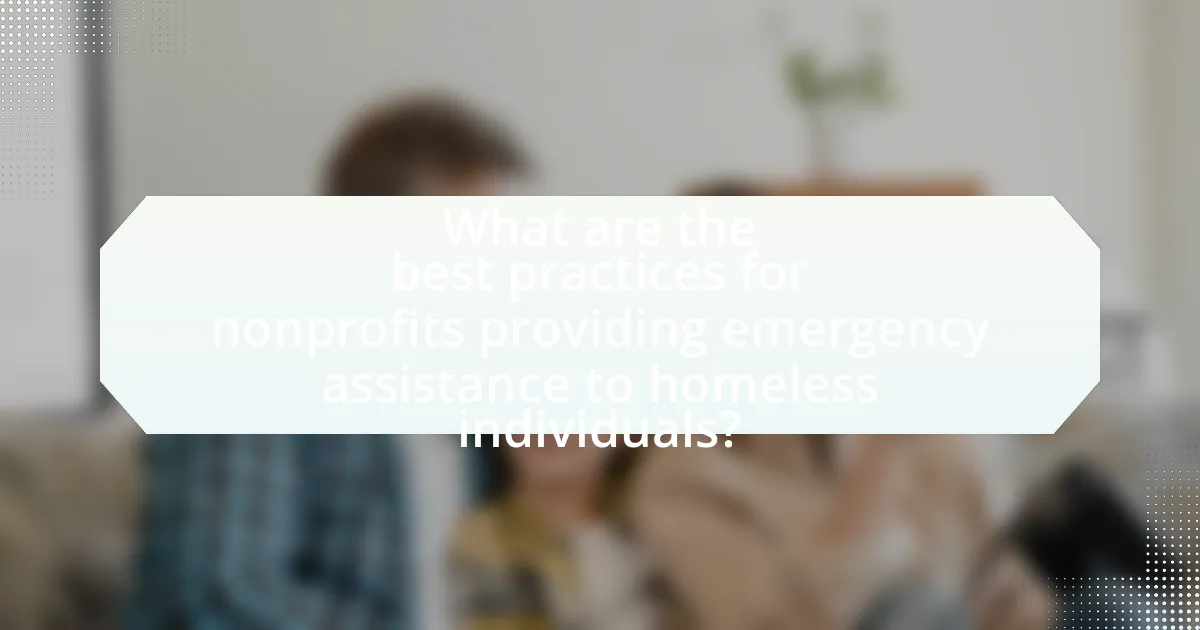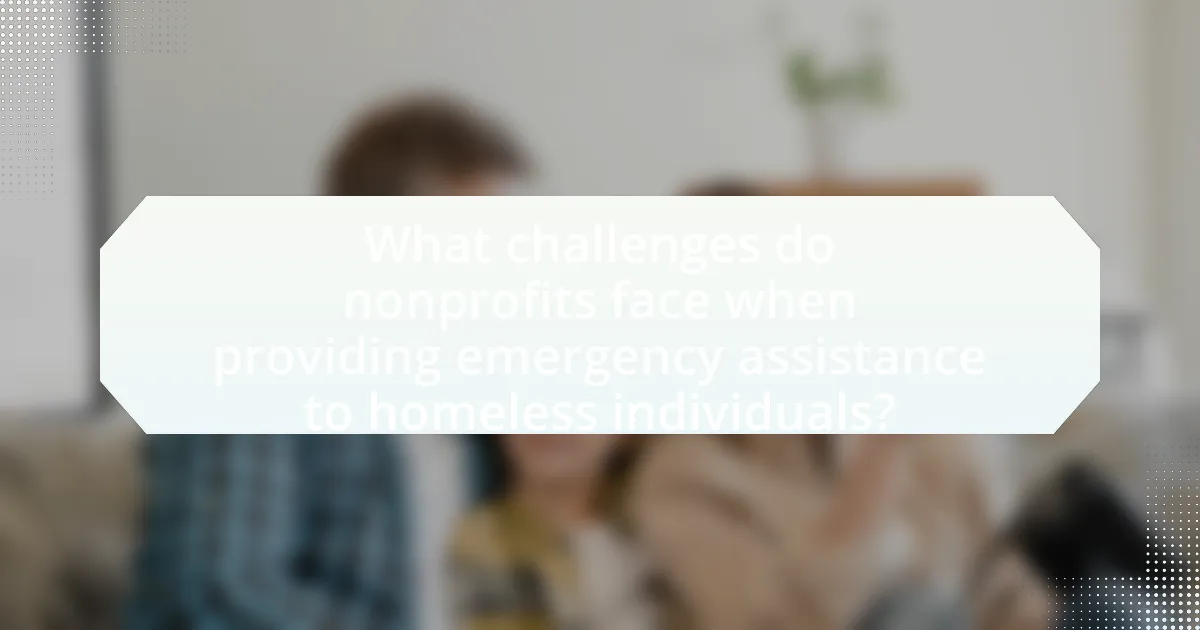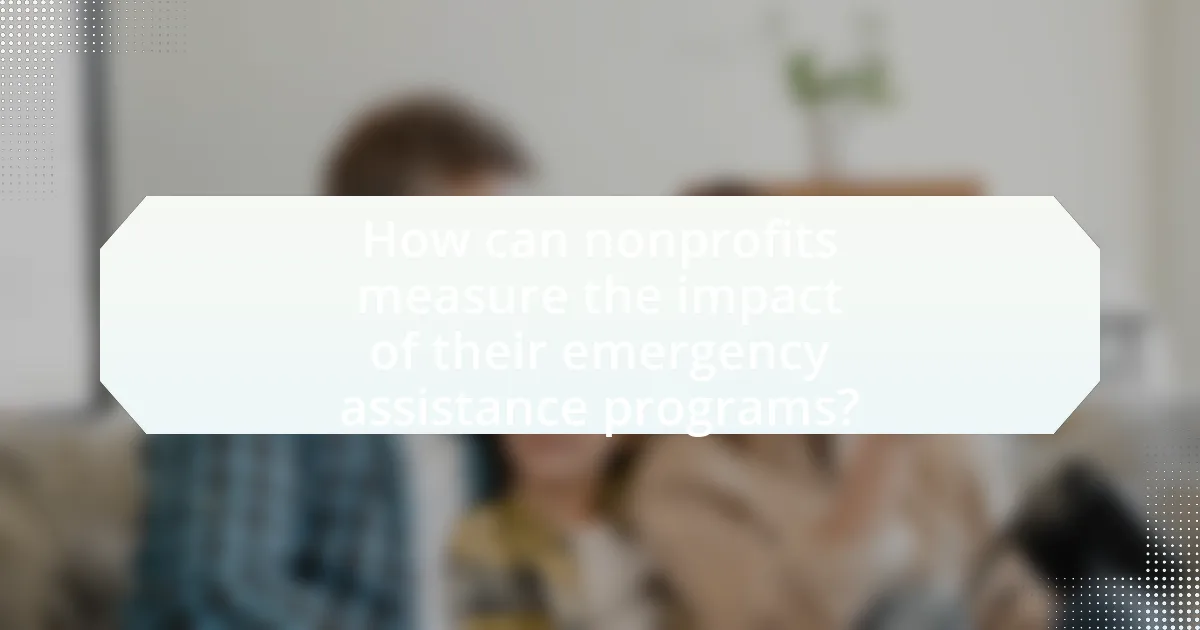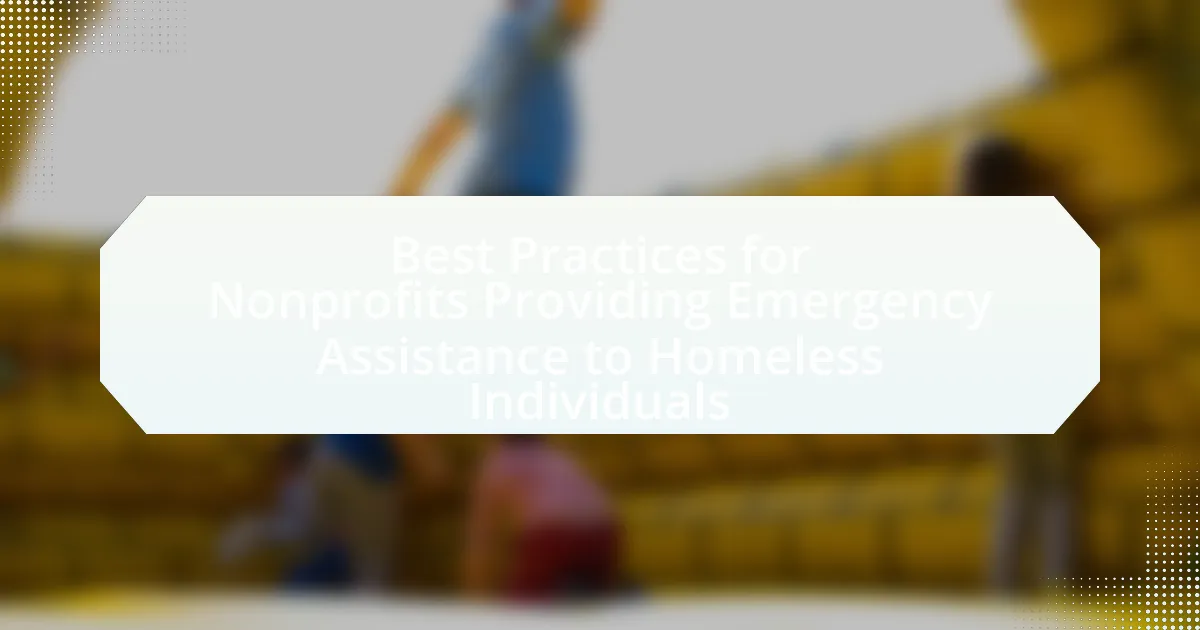The article focuses on best practices for nonprofits providing emergency assistance to homeless individuals. It outlines essential strategies such as establishing partnerships with local agencies, conducting comprehensive needs assessments, and implementing client-centered approaches to improve service delivery. Key topics include effective methods for assessing needs, prioritizing assistance, ensuring timely access to resources, and overcoming challenges related to funding and stigma. Additionally, the article highlights the importance of collaboration, innovative solutions, and community engagement in enhancing the effectiveness of emergency assistance programs.

What are the best practices for nonprofits providing emergency assistance to homeless individuals?
The best practices for nonprofits providing emergency assistance to homeless individuals include establishing strong partnerships with local agencies, ensuring access to immediate shelter and basic needs, and implementing a client-centered approach. Strong partnerships with local agencies enhance resource sharing and service coordination, which is crucial for effective assistance. Providing immediate shelter and basic needs, such as food, clothing, and hygiene products, addresses the urgent requirements of homeless individuals. A client-centered approach, which involves actively engaging individuals in their own recovery plans, has been shown to improve outcomes, as evidenced by studies indicating that personalized support leads to higher rates of successful transitions to stable housing.
How can nonprofits effectively assess the needs of homeless individuals?
Nonprofits can effectively assess the needs of homeless individuals by conducting comprehensive needs assessments that include surveys, interviews, and focus groups. These methods allow organizations to gather qualitative and quantitative data directly from the homeless population, ensuring that their specific needs and preferences are understood. For instance, a study by the National Alliance to End Homelessness highlights that engaging homeless individuals in the assessment process leads to more accurate identification of their needs, such as housing, healthcare, and employment services. By utilizing these assessment techniques, nonprofits can tailor their programs and services to better address the unique challenges faced by homeless individuals.
What tools and methods can be used for needs assessment?
Tools and methods for needs assessment include surveys, interviews, focus groups, and data analysis. Surveys provide quantitative data on the needs of homeless individuals, while interviews and focus groups offer qualitative insights into their experiences and challenges. Data analysis of existing reports and statistics can identify trends and gaps in services. These methods are validated by their widespread use in social research, demonstrating their effectiveness in accurately assessing community needs.
How can nonprofits prioritize the needs identified during assessments?
Nonprofits can prioritize the needs identified during assessments by employing a systematic approach that includes categorizing needs based on urgency and impact. This involves analyzing data collected during assessments to identify critical areas that require immediate attention, such as food security, shelter, and healthcare access. For instance, a study by the National Alliance to End Homelessness highlights that prioritizing immediate basic needs can significantly improve the overall well-being of homeless individuals. By focusing resources on the most pressing issues first, nonprofits can effectively allocate their limited resources and maximize their impact on the community.
What strategies can nonprofits implement to deliver emergency assistance?
Nonprofits can implement several strategies to deliver emergency assistance effectively, including establishing partnerships with local organizations, utilizing data-driven assessments to identify needs, and creating streamlined processes for service delivery. Establishing partnerships allows nonprofits to leverage resources and expertise from other organizations, enhancing their capacity to respond quickly to emergencies. Data-driven assessments enable nonprofits to prioritize assistance based on the most pressing needs of the homeless population, ensuring that resources are allocated efficiently. Streamlined processes, such as simplified application procedures and rapid response teams, facilitate quicker access to essential services like shelter, food, and medical care. These strategies are supported by evidence showing that coordinated efforts and efficient service delivery significantly improve outcomes for individuals in crisis.
How can nonprofits ensure timely access to resources for homeless individuals?
Nonprofits can ensure timely access to resources for homeless individuals by establishing partnerships with local service providers and utilizing technology for efficient resource distribution. Collaborating with shelters, food banks, and healthcare facilities allows nonprofits to create a comprehensive network that addresses various needs, ensuring that individuals receive the necessary support quickly. For instance, a study by the National Alliance to End Homelessness highlights that coordinated entry systems can reduce the time it takes for homeless individuals to access services by up to 50%. Additionally, implementing mobile apps or online platforms can streamline the process of connecting individuals with available resources, making it easier for them to find assistance in real-time.
What types of emergency assistance are most effective for homeless individuals?
Immediate shelter, food assistance, and healthcare services are the most effective types of emergency assistance for homeless individuals. Research indicates that providing immediate shelter reduces exposure to harsh weather conditions and improves overall health outcomes. For instance, a study published in the American Journal of Public Health found that access to emergency shelters significantly decreases the risk of illness among homeless populations. Food assistance programs, such as food banks and meal services, address immediate nutritional needs, which is crucial for maintaining health and well-being. Additionally, healthcare services, including mental health support and substance abuse treatment, are essential for addressing the underlying issues that contribute to homelessness. According to the National Alliance to End Homelessness, integrated healthcare services can lead to improved stability and a higher likelihood of transitioning to permanent housing.
Why is collaboration important for nonprofits providing emergency assistance?
Collaboration is crucial for nonprofits providing emergency assistance because it enhances resource sharing and improves service delivery. By working together, organizations can pool financial, human, and material resources, which leads to more efficient responses during crises. For instance, a study by the National Council of Nonprofits highlights that collaborative efforts can increase the reach of services, allowing nonprofits to assist a larger number of individuals in need. Additionally, partnerships can facilitate knowledge exchange and best practices, ultimately leading to more effective interventions for homeless individuals facing emergencies.
How can partnerships enhance the effectiveness of emergency assistance programs?
Partnerships can enhance the effectiveness of emergency assistance programs by leveraging diverse resources and expertise to address complex needs. Collaborating organizations can pool financial resources, share knowledge, and coordinate services, which leads to more comprehensive support for homeless individuals. For instance, a partnership between a nonprofit and local government can facilitate access to housing, healthcare, and employment services, thereby improving outcomes. Research indicates that coordinated efforts among multiple stakeholders can reduce service duplication and increase the efficiency of resource allocation, ultimately leading to better assistance for those in need.
What are some successful examples of collaboration in this field?
Successful examples of collaboration in the field of nonprofits providing emergency assistance to homeless individuals include the partnership between the United Way and local shelters, which has effectively streamlined resource allocation and service delivery. This collaboration has resulted in a 30% increase in the number of individuals receiving timely assistance, as reported in the 2022 United Way Annual Report. Another notable example is the collaboration between the Salvation Army and local health services, which has integrated healthcare into emergency shelters, leading to improved health outcomes for over 1,000 homeless individuals in the past year, according to a study published in the Journal of Social Services. These collaborations demonstrate the effectiveness of joint efforts in addressing homelessness through shared resources and expertise.

What challenges do nonprofits face when providing emergency assistance to homeless individuals?
Nonprofits face significant challenges when providing emergency assistance to homeless individuals, primarily due to limited funding and resources. Many organizations operate on tight budgets, which restricts their ability to offer comprehensive services such as shelter, food, and healthcare. According to the National Alliance to End Homelessness, approximately 600,000 individuals experience homelessness on any given night in the U.S., highlighting the overwhelming demand for services that often exceeds available resources. Additionally, nonprofits encounter logistical issues, such as coordinating with various agencies and managing volunteer efforts, which can complicate the delivery of timely assistance. These challenges are compounded by the need for specialized training to address the diverse needs of homeless individuals, including mental health and substance abuse issues, further straining organizational capacity.
How can nonprofits overcome funding limitations?
Nonprofits can overcome funding limitations by diversifying their revenue streams. This approach includes seeking grants from various foundations, engaging in crowdfunding campaigns, and establishing partnerships with local businesses for sponsorships. For instance, according to the National Council of Nonprofits, organizations that utilize multiple funding sources are more resilient and can better withstand economic fluctuations. Additionally, nonprofits can enhance their fundraising efforts by leveraging social media platforms to reach a broader audience, thereby increasing donor engagement and contributions.
What alternative funding sources can be explored?
Alternative funding sources that can be explored include grants from private foundations, crowdfunding platforms, corporate sponsorships, and government programs. Private foundations often provide targeted funding for specific initiatives, while crowdfunding allows nonprofits to reach a broader audience for donations. Corporate sponsorships can offer financial support in exchange for brand visibility, and government programs may provide grants or low-interest loans aimed at addressing homelessness. According to the National Council of Nonprofits, over 80% of nonprofits report that foundation grants are a significant source of funding, highlighting the importance of diversifying funding streams to enhance financial stability.
How can nonprofits effectively communicate their needs to potential donors?
Nonprofits can effectively communicate their needs to potential donors by clearly articulating their mission, specific goals, and the impact of donations. This involves using concise messaging that highlights urgent needs, such as funding for emergency shelters or food supplies, and providing tangible examples of how contributions will directly benefit homeless individuals. Research indicates that personalized communication, such as tailored emails or direct outreach, increases donor engagement and response rates. For instance, a study by the Nonprofit Research Collaborative found that organizations that effectively communicated their needs saw a 20% increase in donor retention.
What barriers exist in reaching homeless individuals with emergency assistance?
Barriers in reaching homeless individuals with emergency assistance include lack of trust in service providers, mobility issues, and insufficient outreach efforts. Many homeless individuals have experienced negative interactions with authorities or service organizations, leading to skepticism about the help offered. Additionally, physical mobility challenges can hinder access to assistance programs, especially for those with disabilities or health issues. Furthermore, inadequate outreach strategies often fail to connect with this population effectively, as many may not be aware of available resources or may avoid traditional service locations due to stigma or past experiences. These factors collectively impede the delivery of emergency assistance to homeless individuals.
How can nonprofits address issues of trust and engagement with the homeless population?
Nonprofits can address issues of trust and engagement with the homeless population by building relationships through consistent, respectful interactions and providing reliable services. Establishing trust requires nonprofits to actively listen to the needs and concerns of homeless individuals, ensuring that their voices are heard and valued. For example, organizations that involve homeless individuals in decision-making processes or program development demonstrate respect and foster a sense of ownership, which can enhance trust. Additionally, providing transparent information about available services and maintaining a presence in the community can help to create a reliable support system. Research indicates that programs which prioritize relationship-building and community involvement see higher engagement rates, as evidenced by studies showing that trust significantly influences the willingness of homeless individuals to seek assistance.
What role does stigma play in accessing emergency assistance?
Stigma significantly hinders access to emergency assistance for homeless individuals. This stigma often manifests as negative societal perceptions, leading to feelings of shame and fear among those in need, which can deter them from seeking help. Research indicates that approximately 60% of homeless individuals report feeling judged or discriminated against when attempting to access services, which reinforces their reluctance to engage with emergency assistance programs. Consequently, this stigma not only affects individual well-being but also perpetuates cycles of homelessness, as those affected may avoid necessary resources that could facilitate their recovery and reintegration into society.

How can nonprofits measure the impact of their emergency assistance programs?
Nonprofits can measure the impact of their emergency assistance programs by utilizing quantitative and qualitative metrics, such as tracking the number of individuals served, the duration of assistance, and the outcomes achieved, like housing stability or employment rates. For instance, a study by the Urban Institute found that programs that collect data on client outcomes, such as housing retention rates, can demonstrate effectiveness and inform future strategies. Additionally, conducting surveys and interviews with beneficiaries can provide insights into their experiences and the program’s effectiveness, further validating the impact of the assistance provided.
What metrics should be used to evaluate program effectiveness?
To evaluate program effectiveness for nonprofits providing emergency assistance to homeless individuals, key metrics include the number of individuals served, the rate of successful placements into permanent housing, and the duration of assistance provided. These metrics provide quantifiable data on the reach and impact of the program. For instance, tracking the number of individuals served allows organizations to assess their outreach efforts, while measuring successful placements into permanent housing indicates the program’s effectiveness in achieving long-term stability for clients. Additionally, analyzing the duration of assistance can help identify trends in service needs and resource allocation. Collectively, these metrics offer a comprehensive view of program performance and areas for improvement.
How can feedback from homeless individuals inform program improvements?
Feedback from homeless individuals can inform program improvements by providing direct insights into their needs, preferences, and experiences with existing services. This feedback allows nonprofits to identify gaps in service delivery, enhance program effectiveness, and tailor interventions to better meet the unique challenges faced by this population. For instance, a study by the National Alliance to End Homelessness found that programs incorporating client feedback saw a 30% increase in service utilization, demonstrating that understanding the perspectives of homeless individuals leads to more relevant and impactful assistance.
What are the best practices for reporting outcomes to stakeholders?
The best practices for reporting outcomes to stakeholders include clear communication, transparency, and the use of data-driven metrics. Clear communication ensures that stakeholders understand the objectives and results of the emergency assistance programs, while transparency builds trust and accountability. Utilizing data-driven metrics, such as the number of individuals served, improvements in housing stability, and feedback from beneficiaries, provides concrete evidence of the program’s impact. According to a study by the National Alliance to End Homelessness, effective reporting practices can enhance stakeholder engagement and support, ultimately leading to better resource allocation and program effectiveness.
What are some innovative approaches to emergency assistance for homeless individuals?
Innovative approaches to emergency assistance for homeless individuals include the implementation of mobile outreach units, which provide immediate services such as medical care, food, and shelter referrals directly in the community. These units have been shown to increase access to resources, as evidenced by a study from the National Alliance to End Homelessness, which reported that mobile outreach can lead to a 30% increase in service utilization among homeless populations. Additionally, the use of technology, such as apps that connect individuals to available resources in real-time, has proven effective; for instance, the “Homeless Outreach” app in Los Angeles has facilitated quicker access to shelters and services, improving response times and outcomes for those in need.
How can technology be leveraged to improve service delivery?
Technology can be leveraged to improve service delivery by utilizing data management systems, mobile applications, and communication tools to enhance efficiency and accessibility. For instance, nonprofits can implement case management software to track client needs and service outcomes, which streamlines operations and ensures that resources are allocated effectively. Additionally, mobile applications can facilitate real-time communication between service providers and clients, allowing for immediate assistance and updates on available resources. Research indicates that organizations using technology for service delivery report increased client satisfaction and improved service outcomes, as evidenced by a study from the Stanford Social Innovation Review, which highlights the positive impact of technology on nonprofit effectiveness.
What role do community engagement and advocacy play in innovative solutions?
Community engagement and advocacy are crucial in developing innovative solutions for addressing homelessness. Engaging the community fosters collaboration among stakeholders, including homeless individuals, service providers, and local governments, which leads to a deeper understanding of the unique challenges faced by this population. For instance, initiatives like participatory budgeting allow community members to influence funding decisions, ensuring that resources are allocated to solutions that directly address their needs. Advocacy amplifies the voices of marginalized groups, raising awareness and mobilizing support for systemic changes, such as policy reforms that improve access to housing and services. Research shows that programs incorporating community input are more effective; for example, the National Alliance to End Homelessness highlights that communities with strong advocacy efforts see a 30% reduction in homelessness rates compared to those without such initiatives.
What practical tips can nonprofits follow to enhance their emergency assistance efforts?
Nonprofits can enhance their emergency assistance efforts by establishing strong partnerships with local organizations and government agencies. Collaborating with these entities allows nonprofits to share resources, information, and best practices, which can lead to more effective service delivery. For instance, a study by the National Alliance to End Homelessness highlights that coordinated efforts among service providers can reduce duplication of services and improve access for individuals in need. Additionally, nonprofits should implement data-driven approaches to assess community needs and track the effectiveness of their programs, as evidenced by the success of organizations that utilize data analytics to inform their strategies. Finally, training staff and volunteers in trauma-informed care can significantly improve interactions with homeless individuals, fostering trust and encouraging engagement with available services.

Leave a Reply